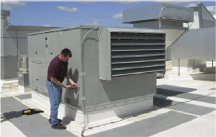Designing a new high school to operate 40% more efficiently than ASHRAE 90.1 standards is a feat in itself. To achieve the same energy standard on a very limited capital budget while designing a state-of-the art and energy-demanding technical vocational high school is an even greater feat. This goal is exactly what the engineers of StudioJAED accomplished at the Providence Career and Technical Academy (PCTA).
PCTA opened its doors to its first class of students on September 2009. The 296,000 s/f vocational school, which includes 72,000 s/f of renovated space from the existing Hanley Vocational School, is a place of high-tech classrooms, equipment, labs, media centers, and athletic facilities. The school offers several career training programs including automotive technology, construction technology, cosmetology, culinary arts, HVAC technology, and general construction trades in addition to a required college-prep curriculum of math, science, and English.
The school was designed and built as a highly efficient building to satisfy the requirements of the Northeast Collaborative for High Performance Schools Protocol (NE-CHPS), a program similar to LEED. Often times, highly efficient buildings come with high premium costs. PCTA, like many public schools, is no stranger to budget constraints. Therefore, designers had to limit initial costs in creative ways.
HVAC Cost Savings with Energy Recovery
One of the major design directives to save on construction costs led PCTA to install a dual temperature two-pipe system for HVAC needs. This is in contrast to the more common (and more expensive) four-pipe system with heating and cooling available at any time. However, the two-pipe system cannot engage cooling coils to reduce humidity on cool, damp days when heating is utilized. The solution to this dilemma was found with Airxchange energy recovery wheels containing a silica gel desiccant material for moisture transfer. By rotating between air streams, the wheels remove moisture from outdoor air on damp days and reject it into the exhaust airstream to keep the indoor relative humidity at a comfortable level. Brian Zigmond of StudioJAED said, "We needed a way to mitigate humidity issues that are typical of the area during the 'shoulder' seasons since the school utilizes a two-pipe system. Rejecting as much humidity as possible back to the outdoors with an energy recovery wheel is the most practical solution available." Installing energy recovery wheels into the HVAC system essentially permitted the effective use of the less expensive two-pipe system.
Reducing Outdoor Air (OA) Load and Staying
"In the Comfort Zone"
StudioJAED also realized during the planning phase that energy recovery would have to be incorporated into the design of PCTA if the 40% energy reduction goal was to be achieved. The team chose to utilize a combination of air handling units and standalone energy recovery ventilators (ERVs) with Airxchange energy recovery wheels to provide outdoor air to the new and retrofitted classrooms, labs, auditorium, and media center at PCTA. The Airxchange wheels help to condition 45,215 CFM of outdoor air by continuously recycling the heating or cooling energy (depending on the season) from the exhaust air stream. On peak design days, the energy recovery provided by the wheels can reduce the outdoor air load by as much as 80%.
The ability of Airxchange wheels to save on energy is evident at PCTA, especially during the heating season. In the first winter of operation, PCTA Facility Manager David Gaudet of Aramark kept his eye on the boilers to ensure they were able to handle the load. He was surprised at how infrequently the boilers actually needed to fire, stating:
With rising fuel prices, the work performed by the Airxchange wheels to reduce boiler operation provides for tremendous cost savings. PCTA HVAC technician Brian Polak added that he was able to shut down the entire boiler system for a few hours to perform emergency work during one of the coldest days of the winter without the system being negatively affected. The ERV and air handling unit system with Airxchange wheels truly does well to keep the school "in the comfort zone" for much of the year without having to energize additional mechanical systems to temper the air.
The Results Speak for Themselves
PCTA operates at approximately 43 kBtu/ft2, which is about 40% lower than the national average for all high schools, not just technical schools. But at the end of the day, the target goal of operating 40% more efficiently than ASHRAE 90.1 standards isn't just a statistic. The improved efficiency yields huge savings on utility bills. For its part, the Airxchange energy recovery wheel reduction in outdoor air load accounts for an estimated $28,000 in annual utility savings. The majority of the savings is realized in the heating months (being located in the northeast), but the wheel benefits the school year-round with its moisture control to maintain superior indoor air quality.
The PCTA community has been very happy with the performance of the ERVs and air handlers with Airxchange energy recovery wheels. The faculty and students are able to work in an environment with excellent indoor air quality. The school administration is saving money on utility costs due to reduced HVAC loads. And finally, the facility maintenance staff has witnessed the impressive capability of the wheels to reduce outdoor air loads and help maintain comfort control.
Key Statistics
Location: Providence, RI
Project Completed: 2009
School Size: 296,000 s/f
Number of Students: 816 (grades 9-12)
Project Scope: New Construction & Renovation
Impact of Energy Recovery Wheels
Outdoor Air Conditioned
by Airxchange Wheels: 45,215 CFM
Outdoor Air (OA) Heating
Load (Design Day): 4.33 Million BTU/hr
Total Recovered Energy: 2.81 Million BTU/hr
Net OA Heating Load: 1.52 Million BTU/hr
Annual Energy Savings: Approximately $28,000
Annual CO2 Reduction: 100 Tons









